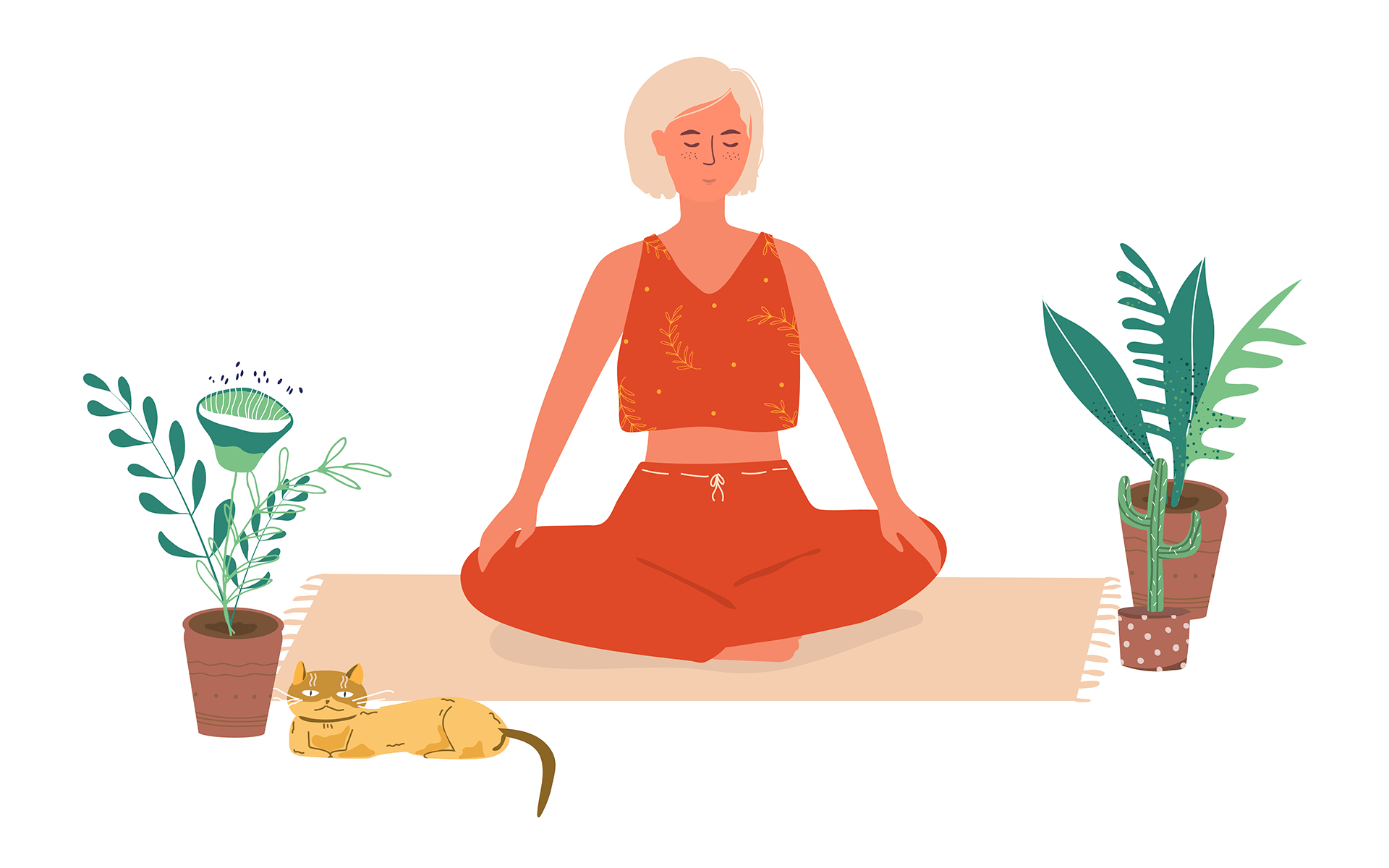Most people struggle when they first start breathing meditation. Here are some of the most common difficulties that arise and ways of working with them.
What if the breath is difficult for me to find or it’s not neutral?
Most people discover that breathing is a good, reliable neutral anchor for them to use in meditation, but a few people find that paying attention to their breathing can make them uncomfortable, even anxious. Others worry that they start to control their breathing when they focus on it (more on this later).
If you prefer not to focus on the breath, there are other anchors you can use in meditation. Some people use sounds or their bodily sensations. In the beginning, try breathing meditation, using your breath as an anchor, for a few weeks and if it doesn’t work for you, feel free to experiment with other anchors.
Most people who prefer not to follow their breathing use sound as an anchor. To do this, simply pay attention to the sounds around you. Let the sounds come and go, in and out of your awareness. Don’t try to figure out the source of the sounds or make up a story about them. Just keep listening to the sounds, and when your mind wanders, continually return to the hearing of the sounds, as recommended with the breath.
Sometimes when I pay attention to the breath, I start to control the breath.
This is a fairly common experience for people. Usually this difficulty shifts over time. Try paying attention to the breath at different parts of your body (abdomen, chest, nostrils) to see whether the same thing happens. You might also try to meditate lying down. Try to relax, soften, and “sneak up” on your breath. If it gets too frustrating, you can switch your anchor to hearing or you can notice changing sensations in your body. You might also ask yourself to notice what a “controlled” breath feels like. What is the direct experience—the felt sense?
Is it okay if I mentally label the breath “in/out”?
Applying a mental label to help keep your attention on your experience is actually a very helpful tool that some people use when meditating. You may find yourself naturally repeating a word or phrase, such as “in/out” or “rising/falling.” Try this technique and see if it works for you. If it is not helpful, just ignore it. Do remember to keep any mental label a very soft whisper in your mind. Keep most of your attention focused on feeling the breathing sensations so that you use the label only as a tool to keep your attention focused and it does not become a distraction or a new focus.
Being with the breath is kind of dull.
Some people do find that paying attention to the breath is dull—certainly not nearly as interesting as scrolling on social media or watching television. Part of what you are learning through meditation is to take interest in things that are not so dramatic. In this utterly sped-up, high-tech world, it can be helpful to retrain yourself to take interest in the “boring” and “dull.” Learning to take an interest in the not-so-exciting experiences of life helps you to appreciate and be present for the simple things of life, rather than constantly seeking new entertainment and experiences to excite you.
Most of us have had 20, 30, 40, 50, or more years practicing being distracted; being able to focus on your breath for an extended period of time is not going to happen overnight.
If you are a little bored while paying attention to your breathing, try to pay closer attention and to take an interest in the minutiae of your breath. Notice how the in breath differs from the out breath. Are two breaths alike? Can you sense a pause between the out breath and the in breath? Is it always the same part of your abdomen that moves, or does it change with each breath? You may be surprised how quickly the boredom can change and how you can transfer this newfound ability to other areas of your life. You may begin to see the world in more detail, as Ethel, a retired nurse and grandmother, reported: “I can’t explain it, but ever since I started meditating, it’s like the world has gotten more vibrant. I see colors more brightly, I hear sounds more strongly. I walk through life with a little more sense of awe and wonder, which is pretty good at 81!”
I think I fell asleep while noticing my breath.
Sleepiness in meditation is extremely common. Don’t get too angry with yourself or discouraged by it. The best remedy is to try to practice at a time of day when you think you will be less tired. You can open your eyes, stand up, or try some walking meditation.
Paying attention to my breathing is difficult.
Many meditation students report how challenging it is to do something that seems deceptively simple. Remember that paying attention to your breathing is not an easy task. Most of us have had 20, 30, 40, 50, or more years practicing being distracted; being able to focus on your breath for an extended period of time is not going to happen overnight. However, you can develop mental fitness by repetitively and kindly coming back to the present moment, just as you would do to develop physical fitness. Over time your mindfulness “muscle” will build. Jackson, a 63 year-old investor, described it this way:
“I was hopeless at meditating. I think I was probably the worst meditator in the class. I don’t think I could stay with even one breath before my mind wandered. I wanted to give up so many times, I have lots of other things to do, yet I knew this would be good for me…So I kept at it, over weeks, months, and believe it or not, over time it started to get easier! I was able to be with a few breaths before wandering, and then longer periods of time. I could sense a very real difference in my mind by the end of the year.”
Practice Mindfulness of Breathing
- Begin this meditation by finding a comfortable place to sit, either in a chair or on a cushion on the floor. As you sit down, notice your posture: Feel your back remaining upright, but not too tense; try to stay relaxed. Keep your eyes closed and your tongue resting on the roof of your mouth or wherever it’s comfortable, and rest your hands on your knees or lap.
- You can then notice your body sitting: the weight, the posture, and the shape of your body. Bring your awareness into your body in the present moment. See if you can notice that one of the sensations in your body is the sensation of your breath.
- Find your breath in your body, feeling your body moving with the breath. Keep your breath completely natural, not elongating it or shortening it in any deliberate way. You might notice your breath in your abdomen as you feel a rising sensation, an expansion, a stretching…then falling, a contraction, a deflation sensation. Or you might notice the breath in your chest, where you feel movement, stretching, and expansion similar to what you feel in the abdomen. Try not to imagine the breath, or to think about the breath, but to feel the breath in your body. You also might notice a subtler presence of your breath in your nostrils—a coolness, a tingling movement. Choose one of these three spots where you feel your breath inside your body—your abdomen, chest, or nostrils—and try to keep your attention on these sensations of breath, one breath at a time…rising, falling…or in, out…
- As you’re doing this, you might notice that your mind wanders and starts to think about all sorts of things. This is completely normal and happens for most people. So when you notice that your mind is wandering or thinking, just relax. You can say a soft word in your mind like “thinking” or “wandering” to acknowledge that you have wandered. And then, very gently but firmly, bring your attention back to the sensations of breathing.
Do this practice in silence for five minutes, feeling one breath at a time, perhaps getting lost in thought, and returning to the sensations of your breath. Increase the amount of time you spend in this practice when you feel drawn to do that.
Excerpted from FULLY PRESENT: The Science, Art, and Practice of Mindfulness by Susan L. Smalley, PhD and Diana Winston. Copyright © 2022. Available from Hachette Go, an imprint of Hachette Book Group, Inc.
read more
Practice the Power of the Long Exhale
Breathe into challenging movement with a longer exhale, whether that be hitting laps on the stairs, running, hiking, climbing, or a high intensity workout.
Read More
A Gentle Movement Practice to Connect With Your Brave Heart
In this seated yoga practice, we cultivate the tools to nurture, strengthen, and give courage to our fearless hearts.
Read More
A Guided Meditation to Train Moment-to-Moment Awareness
When we train our awareness of what’s arising, both internally and externally, we increase our capacity to act with wisdom, no matter what life throws at us.
Read More









